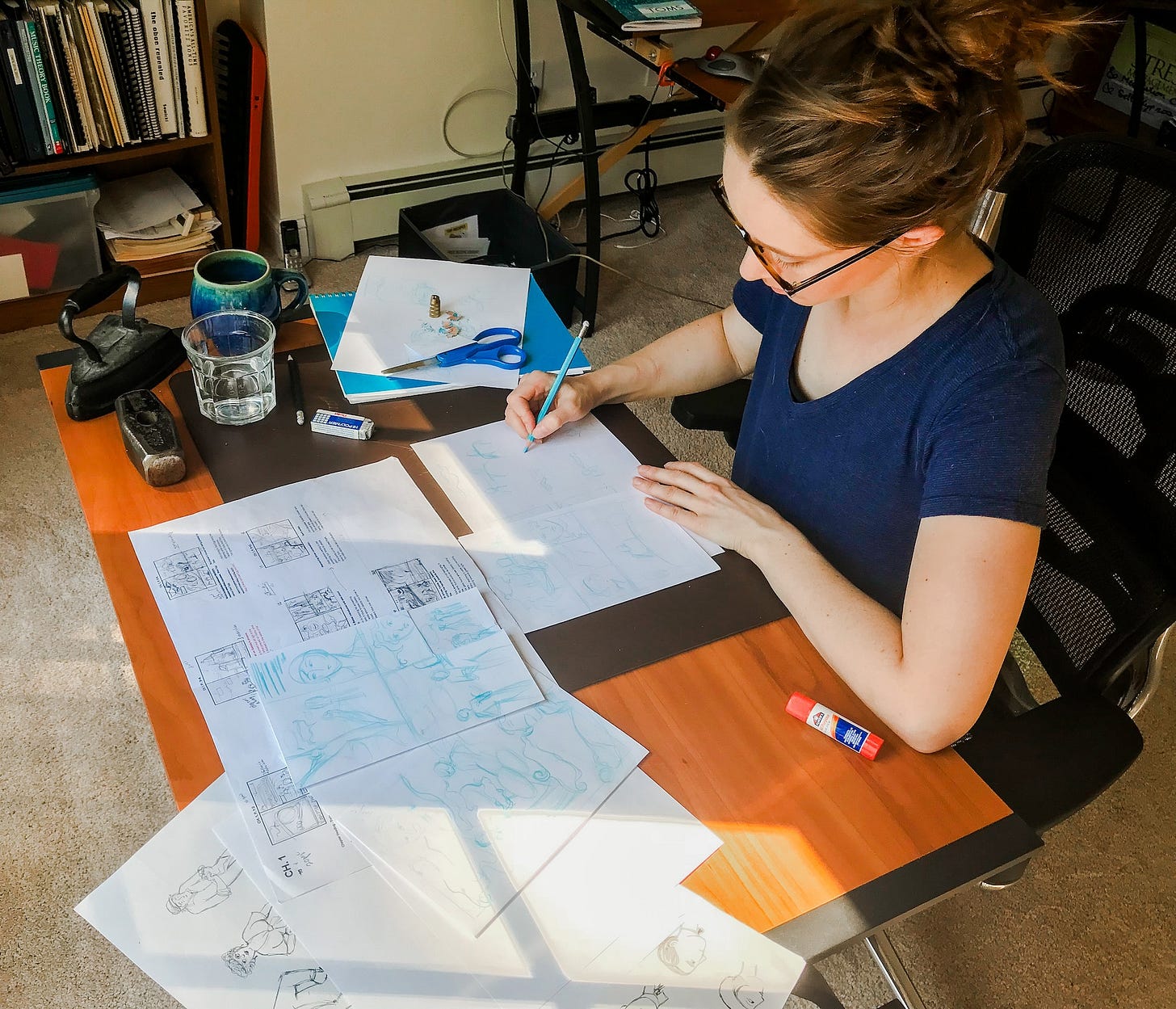Page Turns: Crafting Suspense in Comics
Using Page Layouts to Build Drama and Keep Readers Hooked
Since Halloween is just around the corner, I wanted to share an aspect of storytelling in comics that’s all about suspense: the page turn. A page turn is just what it sounds like—the act of turning the page.
As a graphic novelist, I plan out the page spreads carefully so that I’m building drama, and hopefully so that the reader wants to keep turning the page to keep reading. One tool I have to do this is by putting suspenseful actions on the bottom right corner of a page spread. And then I put the the reveal or payoff on the first panel of the following lefthand page.
Since I’m a visual thinker (and likely you are too), I diagrammed it out to better show you what I mean:
Of course, there are exceptions to this, but it’s a good general rule.
Here’s another example, from the fantastic graphic novel Snapdragon by Kat Leyh. I grayed out most of the page since I want you to focus on the suspenseful lower right panels:
And then you turn the page to this:
Leyh puts the reveal of the ghost-possum in the upper lefthand page for dramatic effect.
Below is an example where I photoshopped these same pages so that the suspenseful panels and the reveal are now on the same page spread. Notice the difference in pacing and decreased impact compared to Leyh’s correct arrangement above:
In the incorrect version, your eye is likely first drawn to the possum ghost on the righthand page, which means you miss most of the great content on the lefthand page until after you see the reveal. And drawing is hard, so you don't want the reader to miss that hard work. The reader may also miss the emotional reaction the creator is trying to get the them to experience.
In my work as a comics coach, I encourage cartoonists to plan out their pages not as individual pages, but as page spreads. This helps them figure out comics pacing and also leads to more appealing and effective page layouts.

And even if you’re only the writer of a comic, and not also the artist (I’m both), I’d also encourage you to plan out the page turns in your script as well. One way I do this is by having each page of my graphic novel script correspond with a page of the art—so p. 112 of my script is p. 112 of my graphic novel. And in my text document, I put the page numbers for the script on the left or right corner of the page, so that it corresponds with the left or right page of the graphic novel. That way I always know where the page turn is, even in script form.
I’d love to hear from you: What are your favorite comics in terms of building suspense and pacing? Do you want me to talk more about page turns? I’ve only scratched the surface and I could certainly go on…!
Suspenseful and Spooky Kid Book Recommendations
Not Quite A Ghost by Anne Ursu
I loved Not Quite a Ghost by Anne Ursu which is about a family who move into a new house and the middle daughter Violet gets the creepy attic bedroom. Soon she falls ill and no one knows what’s wrong or even if it’s a real illness. And soon it’s clear she’s not alone in the attic. From the dust jacket of the books, it’s described as, “an unforgettable and deeply personal story of the ghosts that surround us—and the ones we carry inside.”
Exit Nowhere by Juliana Brandt
I found Juliana Brandt’s Exit Nowhere such an exciting, clever, and satisfying read. From the dust jacket of the book, it’s described as, “Haunted Mansion meets the ultimate escape room in this tense and twisty middle grade horror following four kids who must beat a series of games to make it out of a haunted house.”
Leif Love
One of the most adorable things is Leif trying to catch falling leaves. He even tries to catch them mid-stride during a run. Autumn is so wonderful.
Take care and keep creating!
-Katharine













Just added all of these books to my reading list!
Okay, that was fantastic analysis - and explanation. Especiall the show-dont-tell part.
Now, from what I gathered - the big reveal of the next page also came from the staggered panels on the end of the first pair of pages. Clearly, there was a build up over 2 pages that resulted in the next page 'Surprise!'
I am wondering if it was less staggered - and how it would be if the set-up was that on 2nd page or the right hand side page, there would be a reveal.
Like would a 3 piece only panel on facing (left) page and then Bam! Surprise on the Right page work?